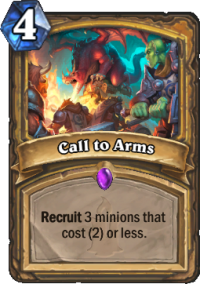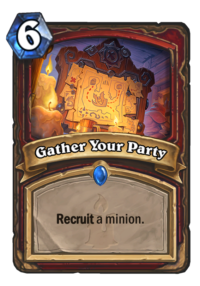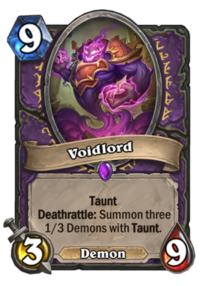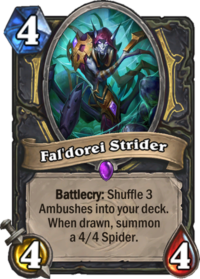With the new Hearthstone year inching ever closer and the upcoming rotation getting rid of some iconic and seemingly omnipresent tools in Standard, it’s time to examine how the different goodies introduced over the course of The Year of the Mammoth fared over the course of their allotted time in the game’s main format. What bombed like hand-buffing and Mean Streets of Gadgetzan and what changed the face of Hearthstone as we know it? This series of articles will examine every keyword introduced in this period, now looking at the infamous Kobolds and Catacombs expansion.
Recruitment Drive
Knights of the Frozen Throne was always going to be a tough act to follow, even with an end-of-the-year set: since those spend the least overall time in the Standard environment, their power levels tend to be a notch higher than the previous ones’. And yet, KnC has found a way through a combination of an excellent single-player content strategy, an underestimated keyword and a set of meta-defining class cards for Hunter, Druid, Mage, Priest and Warlock. Whether this was a good thing or not overall is a very different question – after all, the entire Year of the Raven was a climbdown from the sugar high of 2017 –, but it’ clear that the third year of the set shook up the metagame. In fact, there’s a good argument to be made that the set’s card quality even managed to overshadow that of KoFT.

However, no discussion of the set would be complete without separating the pre-nerf and post-nerf metagame: the dominance of Razakus Priest was essentially uninterrupted until the February patch which would also downgrade the “neutral package” that allowed every class to create a similar sort of tempo deck with Patches the Pirate, Prince Keleseth, Saronite Chain Gang, Cobalt Scalebane, Corridor Creeper, The Lich King and Bonemare. The first and the last on the list plus the giant pink worm would see back-breaking and necessary nerfs applied to them as well, laying the groundwork for a massive shift in the metagame.
This set marked the completion of Druid’s impenetrable shell of cards which allowed for a multitude of similar late-game strategies at the same time. Lesser Jasper Spellstone coupled with Oaken Summons (plus Ironwood Golem) and Branching Paths greatly bolstered the class’ defensive capabilities while Twig of the World Tree provided some interesting combo potential, something that was eventually further explored in the Year of the Raven. The Recruit keyword also gave birth to Taunt Druid thanks to the Hadronox–Naturalize combo and Dragonhatcher. Also, King Togwaggle may have been a joke at this point in time, but Azalina Soulthief certainly changed that perception by the next expansion.
Considering its impact, you’d be surprised by how few Recruit cards were actually printed in Kobolds and Catacombs. The mechanic was criminally underrated before release, in part because of the fact that the initial showcase featured Gather Your Party, by far the weakest of such cards available. Only ten other Recruit cards are present in the game, six of which ended up seeing competitive play and two (Possessed Lackey and Call to Arms) even ending up with a nerf shortly after their release.

It makes sense why the keyword was so conservatively priced and not explored further: it’s a fundamentally uninteractive one, especially considering how the requisite deckbuilding restrictions favor lots of spells and a few specific minions, yet another facet of the game that’s almost impossible to interact with. There’s a reason why Cubelock was such a runaway success in the KnC metagame: early and consistent board flips and insane resource generation was only realistically counterable by relentless aggression – something which was often a problem in Hearthstone around this time with decks like Razakus Priest, Quest Rogue and the like essentially insta-winning against slower opponents.
Keep in mind that every single Warlock class card introduced in the expansion would end up seeing competitive play, something which almost never happens with Hearthstone sets (MSoG’s Priest is the only other example of note). In fact, the infamous Cubelock archetype made use of six out of the ten different ones by itself thanks to the backbone of Dark Pact (originally healing you for 8), Skull of the Man'ari, Possessed Lackey and Voidlord plus the Swiss Army knives that are Kobold Librarian and Lesser Amethyst Spellstone. Some builds also included the criminally underrated Rin, the First Disciple as well. While Vulgar Homunculus was not enough to knock Zoo builds off of their Keleseth-based pedestal, it also became an extremely useful tool in Evenlock alongside Hooked Reaver. Cataclysm rounds off the list as the combo enabler of the Mecha'thun Warlock archetype – it goes without saying that the rotation of this set will redefine the class as we know it today.

It won’t be the only one: Hunter also received some archetype-establishing tools. First of all, the minion-less or “Spell” builds only became a reality in this set after Rhok'delar and To My Side! were printed. Flanking Strike and Wandering Monster provided important minion presence for this kind of deck – also strong enough cards to feature in other archetypes – while Kathrena Winterwisp became an important element of the Deathrattle Hunter archetype. Candleshot would also prove to be a crucial early-game initiative tool (and a Hunter's Mark enabler) in essentially every different Hunter build going forward. The list doesn’t end there. Aggro Mage owns its entire existence over the course of the last calendar year to this set with Explosive Runes and Aluneth – and on the other side of the spectrum, Big Spell Mage could not have become a reality without Dragon's Fury and Dragoncaller Alanna.
Paladin received Call to Arms, Unidentified Maul (the only card with this effect with competitive viability) and Level Up! as enablers of multiple different tempo archetypes, two of which receiving a nerf in due course. Meanwhile, Potion of Heroism and Lynessa Sunsorrow became important cycle tools for OTK Paladin decks.
Treasure Hunt
This was also the high point of Dragon Priest with Twilight Acolyte and Duskbreaker joining the fray, the former comboing extremely well with Potion of Madness for Divine Spirit/Inner Fire OTK shenanigans. Psychic Scream is a must-include premium board clear for any deck of the class, including the Resurrect Priest archetype which also received its foundations here with Lesser Diamond Spellstone and the underappreciated Gilded Gargoyle.
Speaking of the Spellstones, they were a mixed bag: in general, the ones requiring more of a build-around approach fell flat on their face but the ones rewarding you for things you’d do anyway (like taking damage as Warlock or gaining Armor as Druid) slotted well into many different archetypes. (With the legendary weapons, it was more of a trade-off between the tempo loss and the strength of the effect: overall, seven of them saw some sort of competitive play – the exceptions being Priest’s and Shaman’s –, a fairly decent return on a mechanic with easy tech opportunities available to the opponents.)

Even if the Rogue Spellstone turned out to be one of the unplayable ones – no other real Deathrattle synergies really existed for the class after all – it otherwise also received multiple archetype-defining cards: Quest Rogue supercharged itself with Sonya Shadowdancer and Elven Minstrel, Kingsbane Rogue became the ultimate control-killer until the nerf or Leeching Poison, Miracle Rogue got boosted by Fal'dorei Strider and Malygos Rogue eventually got a new lease on life thanks to Kobold Illusionist.
While Shaman basically fell off the face of the earth in this expansion, three of its class cards would become cornerstones for future archetypes: Unstable Evolution, Healing Rain and Grumble, Worldshaker. Warrior is the odd one out (pun intended) as none of its class cards would have significant impact upon release and only Reckless Flurry ended up as an important tool since then thanks to the Odd Warrior builds’ upgraded hero power. It makes sense that these two classes would be rooted to the bottom of the charts at the end of the Year of the Mammoth.
Many neutral cards were also crucial in shaping the KnC metagame: Dire Mole and Plated Beetle were unsung early-game heroes while Zola the Gorgon and Carnivorous Cube broke the boundaries of realistic value options. Arcane Tyrant and Fungalmancer both ended up providing massive tempo swings in the middlegame, though understandably for very different archetypes.
These cards also shook up the Arena experience, but they weren’t the only ones: experts of the limited format also made great use of Lone Champion and the extremely swingy Dragonslayer alongside Stoneskin Basilisk, Shroom Brewer and Violet Wurm.
♪ Running in the dungeon ♫

This expansion marks both the introduction and the high point of Hearthstone’s PvE “roguelike” in the form of Dungeon Run, clearly a reimagination of Peter Whalen’s indie projects Dream Quest and Monster Slayers. It was a runaway success from a player perspective, but a cynical look seems to indicate that its replayability siphoned away way too many players from the ladder population as the later iterations (Monster Hunt and Rumble Run) were greatly downscaled in comparison. It will be interesting to see what kind of a balance The Year of the Dragon’s PvE content will strike in this regard.
All in all, the best way to characterize the Year of the Mammoth would probably be a sugar high, if not for the fact that it was often frustrating even before the climbdown kicked in. Both Recruit and the Death Knights from KoFT were fundamentally un-interactive mechanics, only kept at bay by the tempo package available to every class, creating a same-y mess of a metagame. It’s perhaps a testament to the strength of this set that the most awaited aspect of it has become its eventual rotation to Wild: so many classes will have to be redefined from the ground up that it’s going to shake up the metagame more than we could currently imagine.

Really well written and complete article, nice going
Keep up the good work !